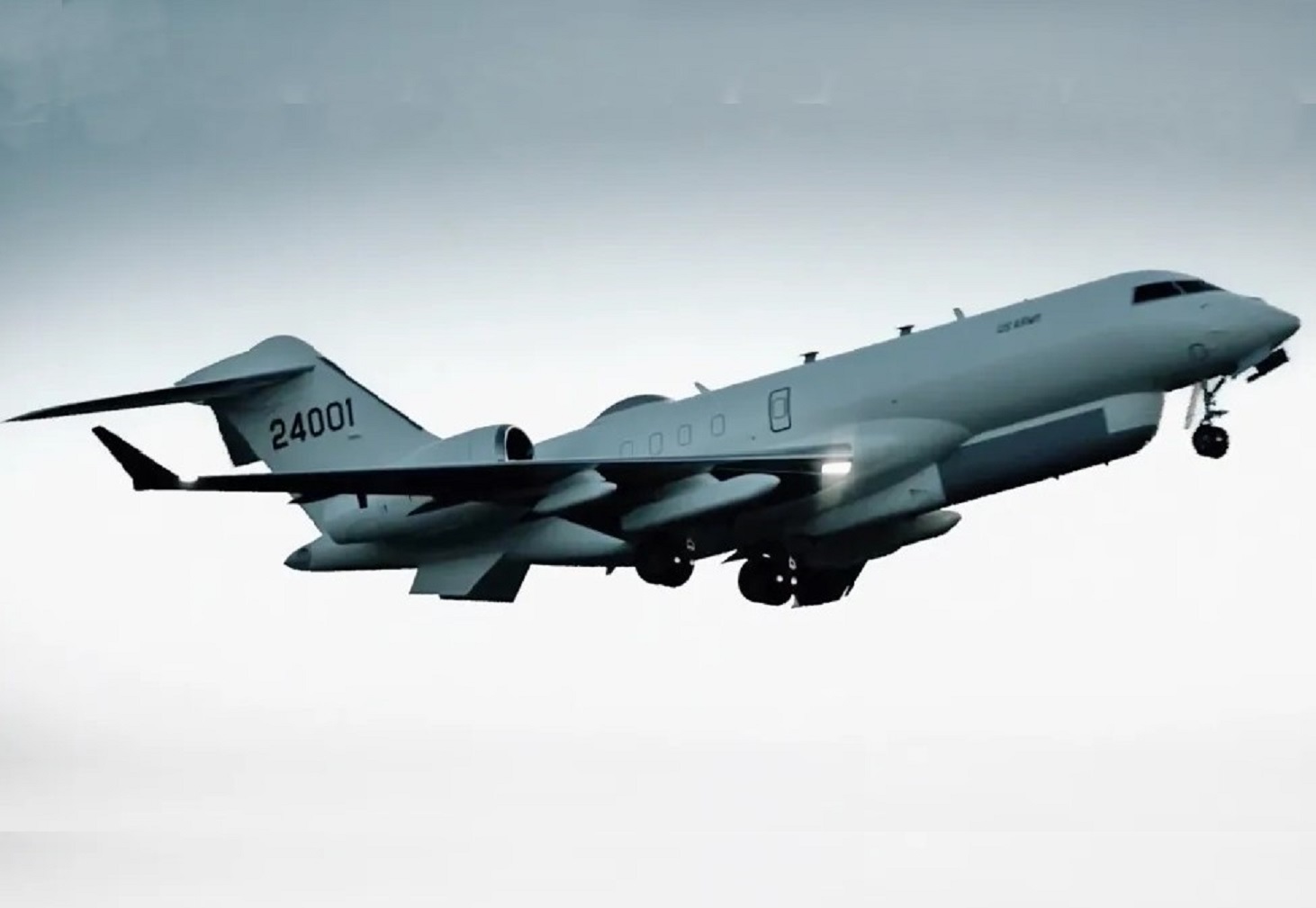Rendering of a future ME-11B showing stores on underwing pylons. U.S. Army,
As modern warfare evolves, the U.S. Army is focusing on advanced intelligence, surveillance, and reconnaissance (ISR) capabilities to maintain battlefield awareness and tactical superiority. At the heart of this effort is the ME-11B, part of the High Accuracy Detection and Exploitation System (HADES) initiative. Built on the Bombardier Global 6500 business jet, the ME-11B is designed to be a high-speed, long-range ISR platform capable of deep sensing operations.
Integration into the Multi-Domain Sensing System (MDSS)
The ME-11B is a crucial element within the Multi-Domain Sensing System (MDSS), which provides a layered aerial ISR approach for long-range sensing. The MDSS initiative seeks to enhance intelligence-gathering across multiple domains—land, air, space, cyber, and electromagnetic—enabling the Army to rapidly achieve situational awareness and decision advantage in contested environments.
MDSS incorporates a family of ISR platforms, including HADES, to extend the Army’s ability to detect, classify, and track enemy activities from greater distances. By combining advanced sensors such as communications intelligence (COMINT), electronic intelligence (ELINT), synthetic aperture radar (SAR), and moving target indicator (MTI) data, MDSS enables forces to map patterns of life, identify threats, and refine intelligence-gathering operations with unprecedented precision.
A New Standard in ISR Capabilities
Historically, the Army has relied on turboprop aircraft for intelligence collection, including platforms like the MC-12S Enhanced Medium Altitude Reconnaissance and Surveillance System (EMARSS) and the RC-12 Guardrail. However, these older systems lack the speed, altitude, and endurance necessary to keep pace with modern threats. The ME-11B aims to fill these gaps, offering a high-speed, long-range, and high-altitude ISR aircraft capable of operating deep within contested environments.
The ASARS-2B radar, originally developed for the U-2 spy plane, plays a central role in the ME-11B’s intelligence capabilities. This Advanced Synthetic Aperture Radar System-2B provides high-resolution imaging that enables military planners to map terrain in exquisite detail. Its ground moving target indicator (GMTI) function allows operators to detect and track moving vehicles—essential for monitoring enemy troop movements, tracking convoys, and gathering intelligence in urban warfare scenarios.
One of the potential game-changing features of the ME-11B is its reported ability to launch drones, which could extend the aircraft’s sensor coverage even further. This capability would allow the Army to deploy remotely operated or autonomous drones from the aircraft to conduct surveillance in areas the jet itself cannot reach, improving operational flexibility and intelligence-gathering efficiency.
The Multi-Mission ME-11B
The “M” in ME-11B designates it as a multi-mission aircraft, reflecting its ability to handle various ISR roles. The U.S. Army has adopted this naming convention for its previous ISR aircraft, such as the MC-12S EMARSS and the Air Force’s MC-12W Liberty, both of which are based on the Beechcraft King Air series. Similarly, the E-11A Battlefield Airborne Communications Node (BACN) aircraft, a militarized version of the Bombardier Global 6500, has provided a precedent for business jet conversions serving ISR and battlefield communications roles.
The ME-11B will be able to operate at higher altitudes, giving it a broader surveillance reach while remaining less vulnerable to ground-based threats. By flying above enemy air defense zones, it can gather intelligence from a safe standoff distance, reducing the risk to operators while still providing high-value reconnaissance.
Development and Production
The journey toward the ME-11B began in August 2023, when the U.S. Army awarded a nearly $1 billion contract to Sierra Nevada Corporation (SNC) to modify Bombardier Global 6500 business jets into HADES-configured aircraft. The contract was briefly challenged by a protest from L3Harris, which partnered with Leidos and MAG Aerospace to bid for the program. After months of legal disputes, the protest was dismissed in January 2024, allowing development to move forward.
The first Global 6500 business jet scheduled for conversion into the ME-11B was delivered in November 2024. This marks the beginning of extensive modifications necessary to equip the aircraft with its advanced sensor suite, new communications infrastructure, and ISR mission systems.
Operational Implications and Strategic Advantage
The ME-11B’s integration into Army operations will significantly improve intelligence-gathering capabilities. By overlaying GMTI data onto SAR imagery, the platform enables military analysts to identify patterns of life, track enemy activity, and predict future movements. These insights are crucial for mission planning, force protection, and counterterrorism operations, as they allow commanders to make data-driven tactical decisions in real time.
Compared to legacy ISR platforms, the ME-11B’s ability to fly faster and farther increases operational reach, allowing it to surveil regions where traditional turboprops may struggle. Additionally, its ability to conduct long-duration missions at high altitude makes it well-suited for monitoring adversary movements across vast landscapes, whether over densely populated urban centers, remote mountainous terrain, or maritime regions.
Beyond battlefield applications, the ME-11B could also be used in humanitarian assistance, disaster response, and border security. Its sophisticated sensors may assist in tracking wildfires, assessing flood damage, or monitoring migration patterns, making it a versatile tool beyond military operations.
Looking Ahead
The Army plans to begin initial acquisitions for the ME-11B in 2024, with expectations for the first deliveries by 2027. As modifications progress, further enhancements—such as expanded communications capabilities and improved drone integration—may be added to bolster the aircraft’s functionality.
The ME-11B represents a crucial step toward modernizing U.S. Army ISR capabilities, aligning with broader Department of Defense efforts to maintain tactical superiority in intelligence gathering. By adopting a high-performance jet-based platform, the Army secures its ability to conduct surveillance operations well beyond current limitations.
In the coming years, as the ME-11B takes to the skies, its role as the eyes and ears of military commanders will shape the future of battlefield intelligence. Whether in conventional conflicts, counterinsurgency operations, or next-generation reconnaissance missions, the ME-11B stands ready to deliver real-time insights with unmatched precision.
Resources
Mission Command Intelligence in Multi-Domain Operations
Army Technology
army-technology.com
Bombadier Defense
defense.bombardier.com
Sierra Nevada Corportation
sncorp.com
*Text and imagery consist of general capabilities information that is not defined as controlled technical data under ITAR Part 120.10 or EAR Part 772.
